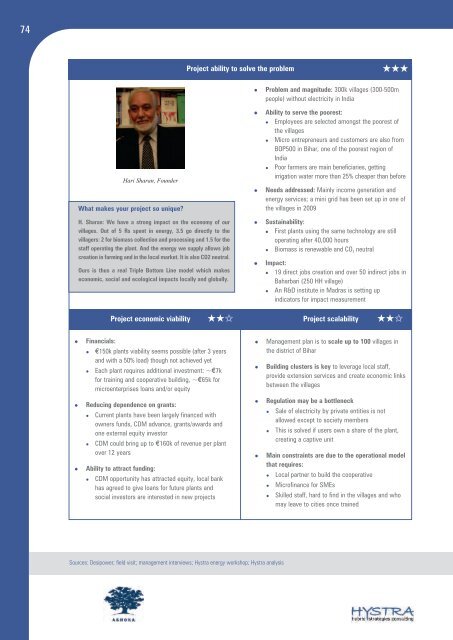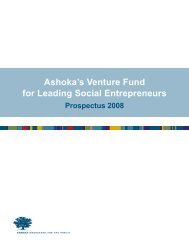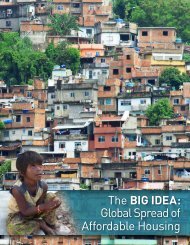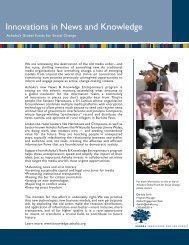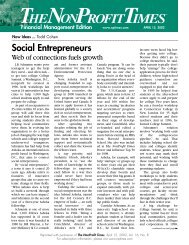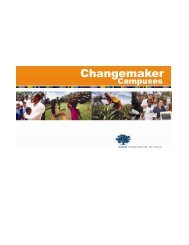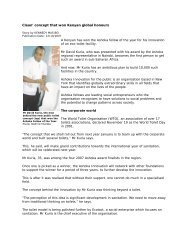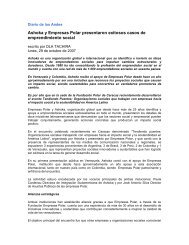Access to Energy for the Base of the - Ashoka
Access to Energy for the Base of the - Ashoka
Access to Energy for the Base of the - Ashoka
You also want an ePaper? Increase the reach of your titles
YUMPU automatically turns print PDFs into web optimized ePapers that Google loves.
74<br />
� Financials:<br />
Hari Sharan, Founder<br />
What makes your project so unique?<br />
H. Sharan: We have a strong impact on <strong>the</strong> economy <strong>of</strong> our<br />
villages. Out <strong>of</strong> 5 Rs spent in energy, 3.5 go directly <strong>to</strong> <strong>the</strong><br />
villagers: 2 <strong>for</strong> biomass collection and processing and 1.5 <strong>for</strong> <strong>the</strong><br />
staff operating <strong>the</strong> plant. And <strong>the</strong> energy we supply allows job<br />
creation in farming and in <strong>the</strong> local market. It is also CO2 neutral.<br />
Ours is thus a real Triple Bot<strong>to</strong>m Line model which makes<br />
economic, social and ecological impacts locally and globally.<br />
Project ability <strong>to</strong> solve <strong>the</strong> problem<br />
� Problem and magnitude: 300k villages (300-500m<br />
people) without electricity in India<br />
�� Ability <strong>to</strong> serve <strong>the</strong> poorest:<br />
� Employees are selected amongst <strong>the</strong> poorest <strong>of</strong><br />
<strong>the</strong> villages<br />
� Micro entrepreneurs and cus<strong>to</strong>mers are also from<br />
BOP500 in Bihar, one <strong>of</strong> <strong>the</strong> poorest region <strong>of</strong><br />
India<br />
� Poor farmers are main beneficiaries, getting<br />
irrigation water more than 25% cheaper than be<strong>for</strong>e<br />
� Needs addressed: Mainly income generation and<br />
energy services; a mini grid has been set up in one <strong>of</strong><br />
<strong>the</strong> villages in 2009<br />
� Sustainability:<br />
�� First plants using <strong>the</strong> same technology are still<br />
operating after 40,000 hours<br />
� Biomass is renewable and CO2 neutral<br />
�� Impact:<br />
� 19 direct jobs creation and over 50 indirect jobs in<br />
Baharbari (250 HH village)<br />
� An R&D institute in Madras is setting up<br />
indica<strong>to</strong>rs <strong>for</strong> impact measurement<br />
Project economic viability Project scalability<br />
�� €150k plants viability seems possible (after 3 years<br />
and with a 50% load) though not achieved yet<br />
� Each plant requires additional investment: ~€7k<br />
<strong>for</strong> training and cooperative building, ~€65k <strong>for</strong><br />
microenterprises loans and/or equity<br />
� Reducing dependence on grants:<br />
� Current plants have been largely financed with<br />
owners funds, CDM advance, grants/awards and<br />
one external equity inves<strong>to</strong>r<br />
� CDM could bring up <strong>to</strong> €160k <strong>of</strong> revenue per plant<br />
over 12 years<br />
� Ability <strong>to</strong> attract funding:<br />
� CDM opportunity has attracted equity, local bank<br />
has agreed <strong>to</strong> give loans <strong>for</strong> future plants and<br />
social inves<strong>to</strong>rs are interested in new projects<br />
Sources: Desipower; field visit; management interviews; Hystra energy workshop; Hystra analysis<br />
★★★<br />
★★✩ ★★✩<br />
� Management plan is <strong>to</strong> scale up <strong>to</strong> 100 villages in<br />
<strong>the</strong> district <strong>of</strong> Bihar<br />
� Building clusters is key <strong>to</strong> leverage local staff,<br />
provide extension services and create economic links<br />
between <strong>the</strong> villages<br />
� Regulation may be a bottleneck<br />
� Sale <strong>of</strong> electricity by private entities is not<br />
allowed except <strong>to</strong> society members<br />
� This is solved if users own a share <strong>of</strong> <strong>the</strong> plant,<br />
creating a captive unit<br />
� Main constraints are due <strong>to</strong> <strong>the</strong> operational model<br />
that requires:<br />
� Local partner <strong>to</strong> build <strong>the</strong> cooperative<br />
� Micr<strong>of</strong>inance <strong>for</strong> SMEs<br />
� Skilled staff, hard <strong>to</strong> find in <strong>the</strong> villages and who<br />
may leave <strong>to</strong> cities once trained


